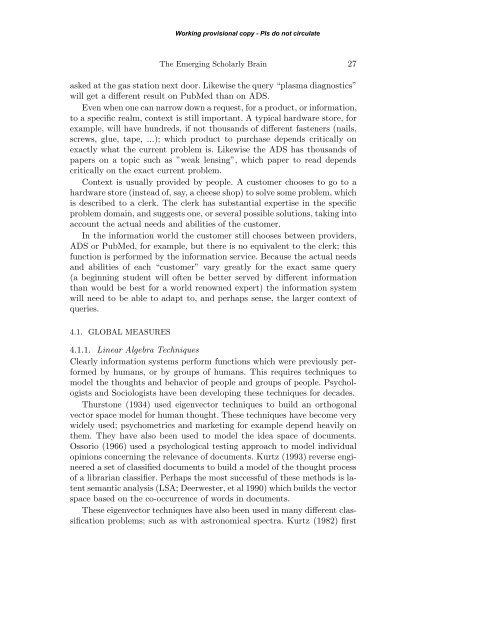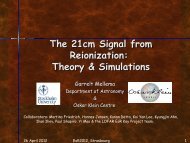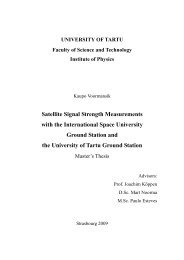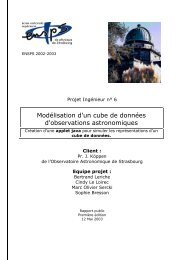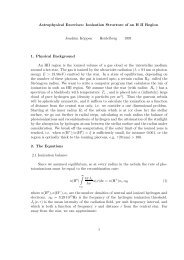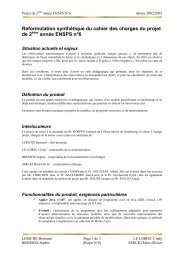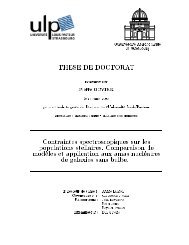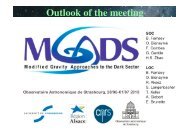View - Observatoire Astronomique de Strasbourg
View - Observatoire Astronomique de Strasbourg
View - Observatoire Astronomique de Strasbourg
You also want an ePaper? Increase the reach of your titles
YUMPU automatically turns print PDFs into web optimized ePapers that Google loves.
The Emerging Scholarly Brain 27<br />
asked at the gas station next door. Likewise the query “plasma diagnostics”<br />
will get a different result on PubMed than on ADS.<br />
Even when one can narrow down a request, for a product, or information,<br />
to a specific realm, context is still important. A typical hardware store, for<br />
example, will have hundreds, if not thousands of different fasteners (nails,<br />
screws, glue, tape, ...); which product to purchase <strong>de</strong>pends critically on<br />
exactly what the current problem is. Likewise the ADS has thousands of<br />
papers on a topic such as ”weak lensing”, which paper to read <strong>de</strong>pends<br />
critically on the exact current problem.<br />
Context is usually provi<strong>de</strong>d by people. A customer chooses to go to a<br />
hardware store (instead of, say, a cheese shop) to solve some problem, which<br />
is <strong>de</strong>scribed to a clerk. The clerk has substantial expertise in the specific<br />
problem domain, and suggests one, or several possible solutions, taking into<br />
account the actual needs and abilities of the customer.<br />
In the information world the customer still chooses between provi<strong>de</strong>rs,<br />
ADS or PubMed, for example, but there is no equivalent to the clerk; this<br />
function is performed by the information service. Because the actual needs<br />
and abilities of each “customer” vary greatly for the exact same query<br />
(a beginning stu<strong>de</strong>nt will often be better served by different information<br />
than would be best for a world renowned expert) the information system<br />
will need to be able to adapt to, and perhaps sense, the larger context of<br />
queries.<br />
4.1. GLOBAL MEASURES<br />
Working provisional copy - Pls do not circulate<br />
4.1.1. Linear Algebra Techniques<br />
Clearly information systems perform functions which were previously performed<br />
by humans, or by groups of humans. This requires techniques to<br />
mo<strong>de</strong>l the thoughts and behavior of people and groups of people. Psychologists<br />
and Sociologists have been <strong>de</strong>veloping these techniques for <strong>de</strong>ca<strong>de</strong>s.<br />
Thurstone (1934) used eigenvector techniques to build an orthogonal<br />
vector space mo<strong>de</strong>l for human thought. These techniques have become very<br />
wi<strong>de</strong>ly used; psychometrics and marketing for example <strong>de</strong>pend heavily on<br />
them. They have also been used to mo<strong>de</strong>l the i<strong>de</strong>a space of documents.<br />
Ossorio (1966) used a psychological testing approach to mo<strong>de</strong>l individual<br />
opinions concerning the relevance of documents. Kurtz (1993) reverse engineered<br />
a set of classified documents to build a mo<strong>de</strong>l of the thought process<br />
of a librarian classifier. Perhaps the most successful of these methods is latent<br />
semantic analysis (LSA; Deerwester, et al 1990) which builds the vector<br />
space based on the co-occurrence of words in documents.<br />
These eigenvector techniques have also been used in many different classification<br />
problems; such as with astronomical spectra. Kurtz (1982) first


